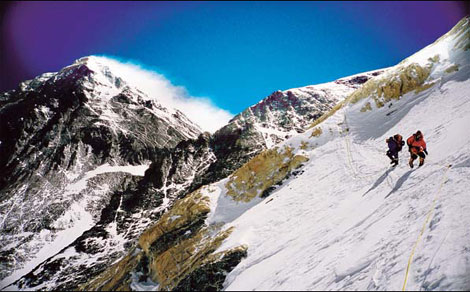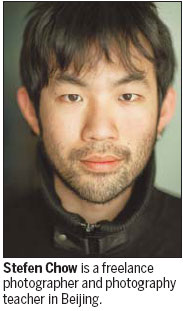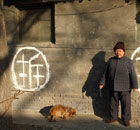Profile
Mountain climber finds inspiration for photography
By Lara Farrar (China Daily)
Updated: 2010-03-15 10:25
 |
Large Medium Small |
Stefen Chow was a mechanical engineer and a mountain climber, not a photographer. Until he began toting a camera with him up the slopes of some of the world's highest peaks. Summit by summit, he began learning how to capture images as beautiful as the moments he was living.
|
 Climbers near the Yellow Band of Himalaya Mountains at height of 7,800 m. Stefen Chow / For China Daily |
By the time he scaled Himalaya Mountains in 2005, Chow knew he had to make a decision, either live life as he had been or give it up fin favor of his newfound passion. He chose the latter.
"A lot of people wondered whether it was the right direction," said Chow, who works as a freelance photographer in Beijing and teaches at the Beijing Center of Photography. "There was a lot of pressure."
Chow's story is an inspiration: A man who risks his life for glimpses of beauty atop treacherous summits decides to take another risk to pursue his love of photography, to capture exquisite glimpses of humanity.
"The results have been gratifying," he said. It was not always so easy. Chow left the career he had built in Singapore, where he was living at the time, for New York City, where he worked for a year without pay as an apprentice with a photographer for National Geographic.
Work came slowly and there were also some setbacks. Shortly before Chow was due to leave for a commissioned project to shoot a skiing exhibition in Iran, he broke his leg, cancelled and was suddenly forced to look for inspiration elsewhere. He chose to explore Brooklyn's population of Hasidic Jews.It took two months to gain their trust, visiting the community, befriending them and trying to understand the intricacies of their identity among the ethnic mix of New York.

"I realized I could create a body of work that can affect people," Chow said. "It was meaningful for me to actually gain access and gain their trust, to show their lives as they are."
The photos signified Chow's transition from amateur to professional. Time, Newsweek, the Wall Street Journal and other major international news outlets are now among his clients.
Chow moved to Beijing in 2008. He said he decided to come to explore the history of his family before they emigrated from China to Malaysia, where he was born. "I wanted to find my roots," he said.
He also wanted the opportunity to photograph a changing China. "You feel the energy, and you see the changes. You just don't see that happening anywhere else in the world," said Chow.
Chow recently wrapped up a project photographing China's leading scientists at research institutions in 20 cities across the country, and he has been working on a project titled Imperial Awakening, a photo essay on the contrast between cultural artifacts in China and the rapidly modernizing society that surrounds them.
"To me, it is really interesting because I feel like in the process of doing this body of work, I make connections with my ancestry," he said.
Chow is now in Singapore editing a photo essay of shipyard workers who he spent two years photographing. The collection will be published later this year.
"In order to get a picture that moves people, you need to be a photographer who understands the issues. I try to go very deep into my subjects," he said. "Only when you understand who you are photographing, understand the situation in front of you, are you able to tell the story within."
"I am lucky I am able to say what I do for a living is also what I love. I can't waste the chance."







